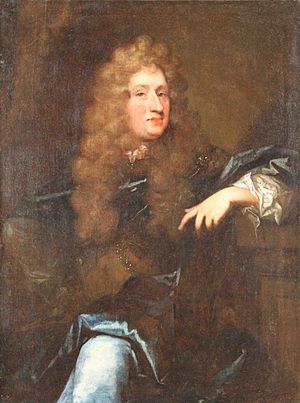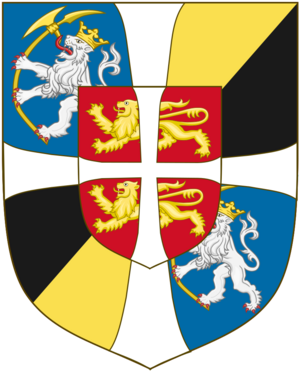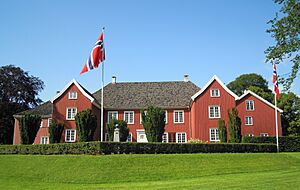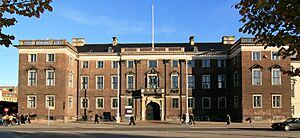Ulrik Frederik Gyldenløve facts for kids
Quick facts for kids
Ulrik Frederik Gyldenløve
|
|
|---|---|
 |
|
| Born | 20 July 1638 Bremen, Germany |
| Died | 17 April 1704 (aged 65) Hamburg, Germany |
| Awards | Order of the Elephant |
| Spouse(s) | Sophie Urne Marie Grubbe Countess Antoinette Augusta of Aldenburg |
Ulrik Frederik Gyldenløve (born July 20, 1638, died April 17, 1704) was a very important person in Norway. He served as the Governor-general of Norway from 1664 to 1699. This means he was the king's main representative in Norway.
He was also a top general for Norway during a big war called the Scanian War. The part of this war fought in Norway is even named the Gyldenløve War after him! He was also known as the Landgrave of Laurvig in Norway.
Contents
Early Life of Ulrik Frederik Gyldenløve
Ulrik Frederik Gyldenløve was born in Bremen, Germany. His father was Prince Frederick, who later became King Frederick III of Denmark. His mother was Margrethe Pape.
When his father became King of Denmark-Norway in 1648, Ulrik Frederik took the last name Gyldenløve. This name was often used by sons of Danish kings who were born outside of marriage.
In the early 1650s, he traveled around Europe. He visited countries like France, Italy, and Spain. He also studied at the University of Siena in 1654. In 1655, he became a Danish noble.
Ulrik Frederik Gyldenløve's Military Career
Ulrik Frederik Gyldenløve started his military career early. In 1657, he became a colonel in Norway. He fought in the Dano-Swedish War (1658–1660).
He showed great bravery in the Battle of Nyborg on November 14, 1659. In 1661, he was put in charge of Vordingborg and Kalø Castle. In 1666, he became the commander-in-chief of the Norwegian army. His army won many battles in the Scanian War (1675–1679).
His Role in Norway and Important Changes
In 1664, Gyldenløve became the viceroy (Statholder) of Norway. He took over from Iver Krabbe. He carefully studied the conditions in Norway.
He strongly supported many important changes. These included making the tax system simpler. He also helped create a separate court of appeals in Norway. This court was separate from the one in Denmark.
Gyldenløve also played a big part in building and improving nine fortresses. These fortresses were built along the border with Sweden. He continued reforms started by an earlier Governor-General, Hannibal Sehested. These reforms helped with taxes, defense, and justice. They also protected farmers who rented land.
In 1671, Gyldenløve founded the city of Laurvig, which is now called Larvik. He was named the Count of Laurvig. In Larvik, he is remembered for building Larvik Church (Larvik kirke). This is the main church in the city.
He also built Laurvig Manor House (Laurvig Herregården). This manor house is still one of the largest wooden buildings in Norway. Larvik Church opened in 1677. Gyldenløve gave money to the church to help with its upkeep. The manor house was finished in 1677.
Charlottenborg Palace and Gyldenløve
In Copenhagen, there was a place known as Gyldenløve Chamber. This place later became famous as Charlottenborg Palace (Charlottenborg Slot). King Christian V of Denmark gave this land to Ulrik Frederik Gyldenløve in 1669.
Gyldenløve built his new mansion there between 1672 and 1683. It was the first big building on the new square called Kongens Nytorv.
Ulrik Frederik Gyldenløve's Family
Ulrik Frederik Gyldenløve was married three times. He had children who lived to adulthood and had their own families.
From his first marriage to Sophie Urne:
- Woldemar Gyldenløve (1660–1740), who later became Baron of Lowendal. He was the father of a famous German officer, Ulrich Frédéric Woldemar, Comte de Lowendal.
- Carl Løvendal (1660-1689), who died on a ship near the island Saint Thomas.
From his third marriage to Countess Antoinette Augusta von Aldenburg:
- Countess Charlotte Amalie af Danneskiold-Samsøe (1682-1699). She married Christian Gyldenløve, who was also a son of a Danish king.
- Ulrikke Amalie Antoinette af Danneskiold-Samsøe (1686-1755).
- Ferdinand Anton Danneskiold-Laurvig, Count af Danneskiold-Samsøe (1688-1754).
Through his daughter, Charlotte Amalie, Ulrik Frederik became an ancestor of the Dukes of Augustenborg. This means he is related to important figures like Frederick VIII, Duke of Schleswig-Holstein, and the German Empress Augusta.
See also
- Gyldenløve
Other sources
- A History of Norway by Karen Larson, (Princeton University Press) 1948
- The History of the Norwegian People by Knut Gjerset, (MacMillan) 1915
- Ulrik Frederik Gyldenløve by Otto von Munthe af Morgenstierne (København, E. Munksgaard) 1944





